How do I Effectively Use Time Management in Teaching Science Lessons?
Time Management in Teaching Series Part 3
There was a time that I questioned my ability of time management in teaching. You’re teaching your lesson, and the kids are engaged, but all of a sudden, the bell rings! Class is over?! Kids are racing to clean up and pack up so they’re not late for their next class. You’re apologizing and rushing them out the door. You may have been there, or maybe you’re there now.
I was there for a long time. I used to say that my weakness was time management in teaching.
But guess what? I changed that narrative! Now, it is a strength of mine. And today I am going to share five tips for time management in teaching lessons in your Science classroom.
In this Post
I will go over the different types of lessons we teach in our Science classes. First, I will break down how I divide up a unit or topic, and schedule it in my calendar. Then, I will share an idea of how long activities should take, based on my classroom and students. Your time frames may be a little different, but overall, we should be pretty close to each other in timeframes. Last, I will share some tools you can use to help you keep track of time.
No matter what you are teaching, be sure you are using using the strategies in 5 Daily Must-Do Routines to Run Your Classroom Like a Pro. Get your guide now by clicking this link or entering your email address to the right.
Disclosure: This post contains some affiliate links for your convenience. As an Amazon Associate I earn from qualifying purchases with no cost to you.
Planning your Lessons
This post isn’t going to go into great detail of how to plan, or what lesson plan format to use. But, I will mention that most Science lessons do not always follow the traditional lesson plan formats. Sometimes our lessons go over a two day period. We may not get to the “closing” until Friday. So, keep that in mind as I share how I plan a unit or topic. Read more about lesson planning in this blog post.
When planning, I like to use the backwards design plan. It’s important to look at the state standards and how I will assess my students. Knowing this, I go through my brainstorming process. I go through my adopted resource first. I look at the whole unit, lesson by lesson. For each lesson, I write down key vocabulary and concepts being taught. I look at the activities and labs that my adopted resource has available. Then, I go to the other resources that my district has purchased for us and write down those related activities and videos. After that, I create my own resources to fill in any gaps. I look for or create labs and projects for the unit.
Once I have that done, I get my calendar and pencil it in. I know roughly how long a lesson will take to teach, a lab will take to complete, or how long students might take on certain activities. And remember to have extra activities, for those fast finishers or for an added challenge. I do not believe in simply assigning more work for these kids, but I do believe in challenging them further. I will write about that in a future post.
Time management in classroom teaching
Now that the activities for the unit are scheduled, let’s look at the length of time different lessons may take. The calendar I have used to jot down these lessons is something that changes. I review my calendar almost daily to make sure I am on track or to adjust lessons depending on the time it is taking my students. But first, here’s what a typical class period looks like.
Time Management in Teaching Tip 1: Know How Much TIme You Have to Teach
Our class periods are about 60 minutes long. When the students come in, they begin their bell work. I post this on the screen and while they are working, I am taking attendance. I use this time to catch up on students who were absent, or missing assignments, and things like that. Then we begin our lesson or activity for the day.
5 minutes- Bell work
45-50 minutes- lesson or activity (notes, labs, or independent or partner work)
5-10 minutes- closing, exit ticket, and clean up
Being aware of your available time to teach is so important for time management and teaching.
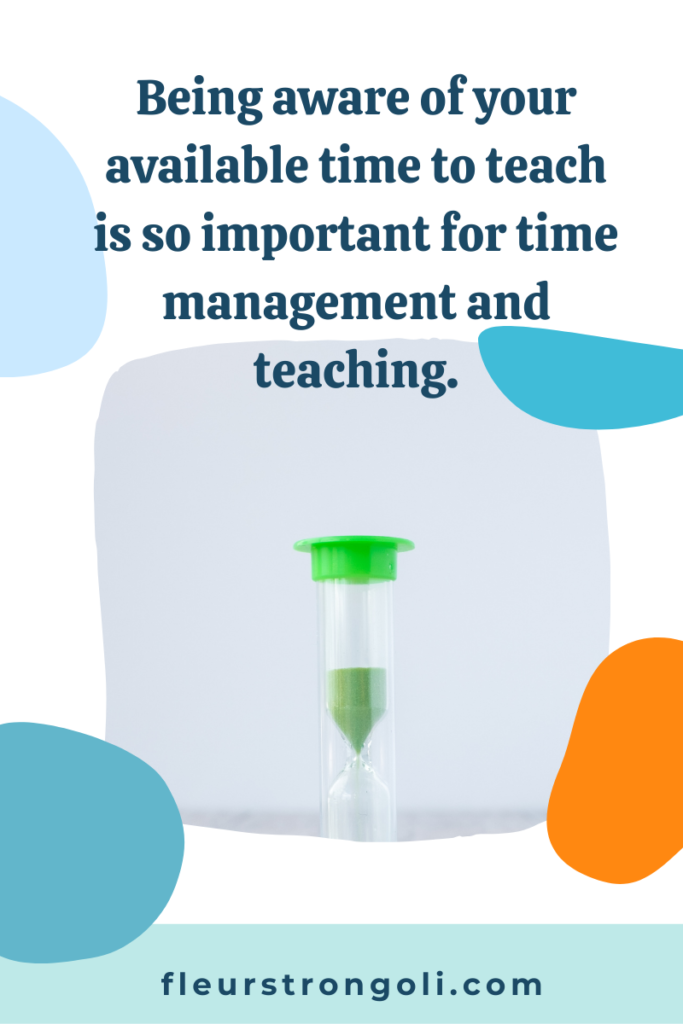
Time Management in Teaching Tip 2: Know How Long it Takes to Present New Information
Teachers present new information in a variety of ways. Some like to teach the whole group with a presentation and note-taking. Others might pose a question or challenge, and have the students find the information together. Then they will go over the information together. Either way is awesome, and they both take about the same amount of time.
When presenting new information to students, I would estimate it would take at least one class period, and at most two class periods. And I learned that Fridays are not the best days for note-taking. Try to schedule your note days on Monday-Thursday.
If students will be sitting for a long period of time, be sure to build in brain breaks into your lesson. We want to make sure students are engaged in their learning and movement is key. My most favorite brain break during these lessons is writing vocabulary in the air or acting it out. That way students are moving and interacting with the content.
And a bonus tip for you, my fellow teacher, is to do one of two things on note-taking days. If you teach different types of classes (advanced vs. grade level or two different Science courses), I recommend scheduling note-taking days on different days for those classes. That way you are not talking ALL day long!
And another bonus tip for you is to record your presentation so you don’t have to talk all day! I use Screencastomatic to record my presentation. It allowed me to flip between the Power Point and my document camera so students knew what to write in their notebooks. You could also record your Power Point in Power Point, or open a Zoom room and record there. During the class period, I press play so the students can watch the lesson. I will pause and go over concepts for clarification. I also upload the video to our private class YouTube channel and Google Classroom. This tip is also helpful when you have a sub!
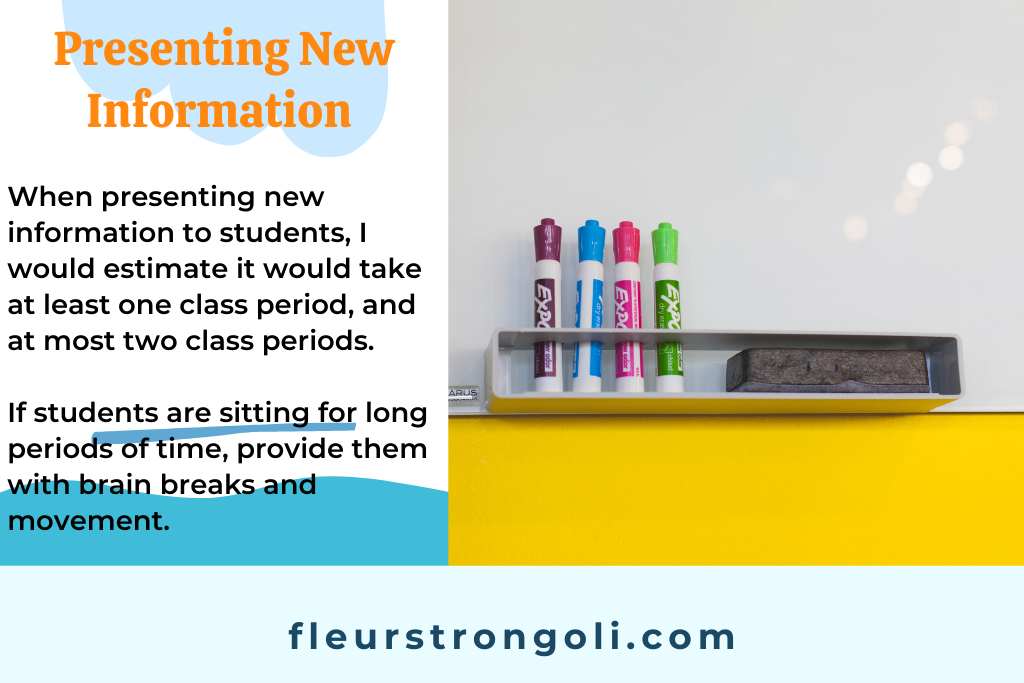
Time Management in Teaching Tip 3: Have a Good Idea of How Long a Science Lab Takes
One of the perks of being a Science teacher is doing labs! Now, this takes some serious time management and preparation. And, each lab takes a different amount of time to complete.
The time it takes to prepare a lab can take some time. You can either set up all of the materials at each lab station, or you can have a materials area and the students can set it up for you.
In addition to preparing the materials for a lab, there are other things that happen before students begin working. So from start to finish, a lab can take anywhere from 20 minutes to the whole class period.
A way to find out how long it might take your lab is to complete it before the students do. That’s also a good time to record yourself completing the lab, so you can post that online for any absent students too. It makes catching up on work a little easier.
If your lab is short, make sure to plan some kind of independent activity that students can complete. If it is long, make sure students are able to complete it and clean up. They can always write their conclusion for homework.
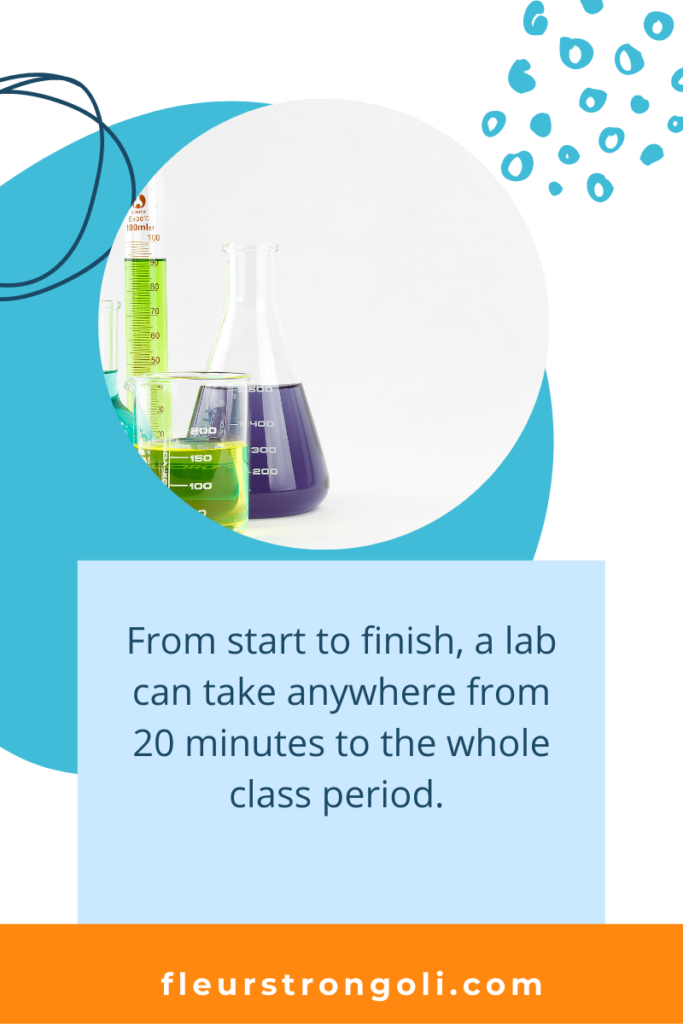
Time Management in Teaching Tip 4: Give Appropriate Amounts of Time for Independent Work
Students need time to practice what you’ve taught them. There are many different ways to do this. You can assign individual assignments, provide a choice board or choice menu, or have students work through stations. The important thing is to keep students engaged during the class period by providing them with meaningful work and allowing them to move around or work with others.
Some individual assignments may take a whole class period, but most students will likely finish in a shorter amount of time. I like to make sure I have at least two assignments for students to work on, so they don’t have a lot of down time during class.
Other options include choice boards or choice menus. Students have to select three or more assignments to complete over a period of 2-3 days. Typically, they would have the entire class period to work on the assignments.
Another option is to rotate students through stations. Plan to set up at least four stations for students to rotate through. They should spend about 15 minutes at each station. You can either let them choose a station and move at their own pace, or assign their station and rotate them with a timer. If you have more than four stations, plan to do stations over two class periods.

Time Management in Teaching Tip 5: Students Need Time to Complete Projects
The final type of assignment to discuss are projects. This could be an individual, partner, or group project. It’s important to chunk the project into parts for students. Offer one or more class periods for research or planning. Then give at least two class periods to work on the actual product. You can also assign parts of it to be completed at home for longer projects, or if you are short on class time. When completing projects in class, plan to have students work on them during the whole class period for at least three days.

Bonus Time Management in Teaching Tip: Use Tools to Help Manage and Keep Track of Your Time!
There are some strategies you can use to help you manage and keep track of time during lessons. There are different types of timers you can purchase or use for free online. I like to post an online stopwatch on the screen to help me keep track of time. It also helps the students!
Another tool we all have in our classrooms are the students! Have one or two students be your time keeper. We already know they’re watching the clock, so ask a student to tell you when it’s a certain time.

Wrap Up
Time management in the classroom is important. Knowing what you are teaching, and how long lessons or activities will take is key. Different parts of Science lessons take various amounts of time. When planning your class period, save at least five minutes at the beginning and at the end of class for routines. Then use the time left for your lesson or activities.
Whole group lessons, such as note-taking, will take 1-2 class periods. Be sure to give students brain or movement breaks when they are sitting for long periods of time. Science labs can take anywhere from 20 minutes to a whole class period. Independent work, choice boards or menus, or stations should take a whole class period. These may be assigned over a 2-3 day period. Finally, if you have students complete projects in class, give them at least three whole class periods to work on it.
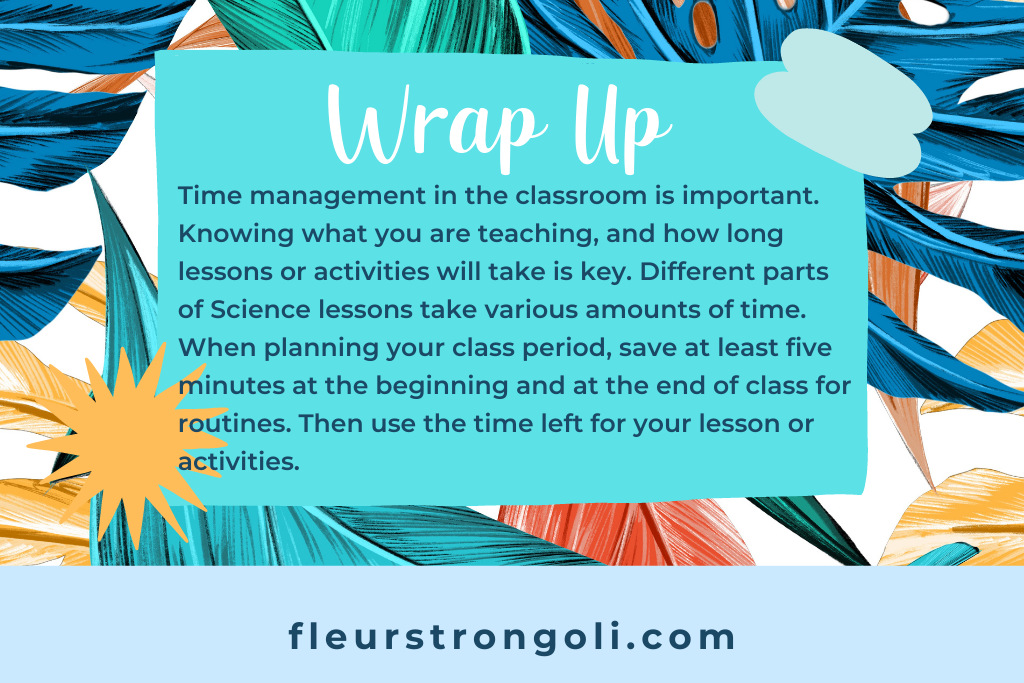
Next Steps
Keep track of how long lessons are taking you? Have you noticed that different class periods finish faster than others? What strategies will you apply to help you manage your time with those faster or slower moving classes? Keep me posted on your progress and school year!
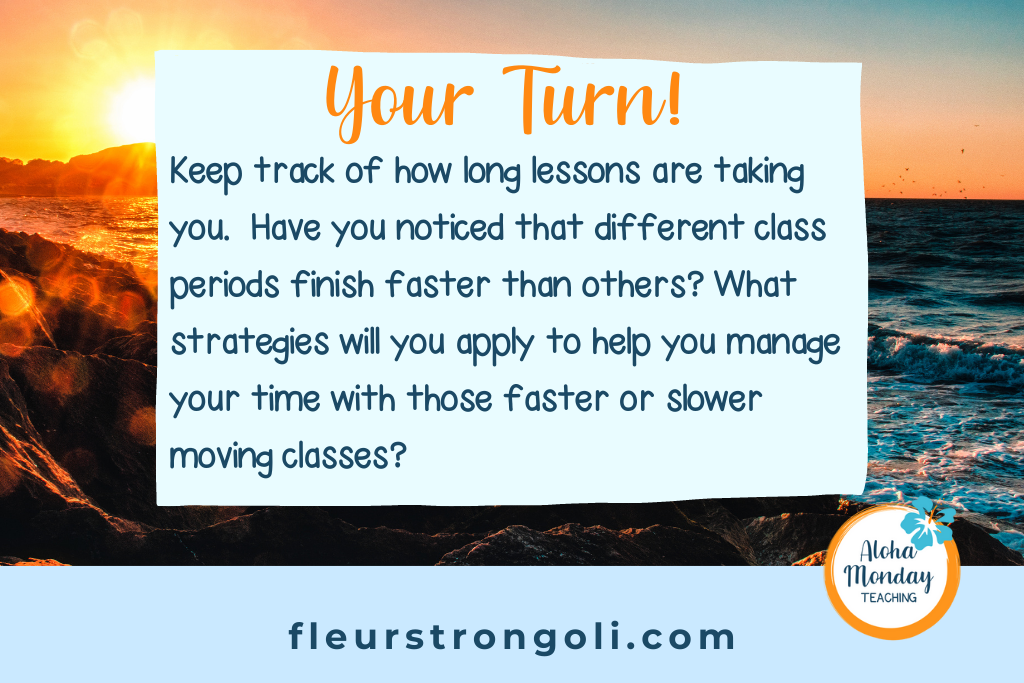
Read More
Part 1: 3 Characteristics to Develop to Know How to Time Management at Work
Read Part 2: 5 Simple Time Management at Work Tips to Finish your Work AT Work
How do I Make Lesson Planning of Science Simple and Focused?
Go to my Resources page to find books and classroom supplies that have helped me!
Get your free planning calendar for the school year in my TpT store! Visit my store for engaging Science products.








3 Comments